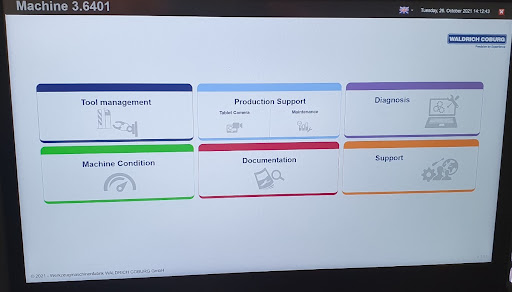How to achieve process consistency on large prismatic machines

Achieving process consistency on large machines requires intricate planning and expert knowledge. In this guide, we will briefly outline the building blocks that guarantee process consistency.
As with any detailed process, we encourage you to get in touch with our experienced Large Prismatic Machining (LPM) team for further advice.
Process consistency on large machines, at a glance:
- Ensure careful process planning and production engineering; this requires a sympathetic process which maximises automation techniques and principles.
- Ensure machinery and processes are within specification before you start.
- Careful and constant monitoring.
- Use process intelligence in order to benefit from the monitoring results.
- Put your value in your automation and front-end engineering.
IN MORE DETAIL:
1. Gather measured performance data
The first step to ensuring process consistency is to know the performance of your machine(s). This provides verification of performance capabilities. Without this, you can’t know for sure how your component or part will turn out.
It is imperative that engineers check the machine’s accuracy before the process begins, especially if the components are of high value, or take a long time to produce. By doing this, you will help prevent time wastage and expensive reworks or scrappage.
When gathering performance data, engineers will be able to ascertain if a machine is working within its design specification. They may discover a discrepancy between the targeted performance and the machine’s actual performance that must be addressed before starting a run.
These measurements are generally done periodically, manually or automatically, depending on your machine and the machine’s manufacturer. Kingsbury would recommend using an automated process where possible; this removes the variation of manual checks and will accurately measure geometric tolerances, essential for multi-axis and rotary-axis machines.

(All Waldrich Coburg machines can be equipped with their ‘InPro’ monitoring systems. These systems monitor numerous aspects of the machine’s ongoing life cycle performance and track any variations from the benchmark parameters obtained at initial installation. The early identification and diagnosis of machine wear, drift or deterioration allows operators to proactively address issues or replace parts before they become a breakdown or process stoppage.)
2. Use a sympathetic approach to your machining processes
This is undoubtedly one of, if not the most crucial steps to ensuring process consistency on large machines.
A careful, engineering-led approach to process methodology is best practice here, especially if your solution is automated.
To have the correct approach to your machining process, it is vital you have a highly-skilled engineer at the front of your solution. The steps taken before starting your production run are the most critical to ensuring consistency and success, so the critical decisions must be made well in advance of the raw material being loaded onto the machine.
Creating a consistent, fast, accurate and predictable process requires a system that is designed carefully and sympathetically; this reduces errors, reworks and scrappage, maximising throughput and profit.
What we mean by a sympathetic approach to machining is an approach that doesn’t worship cycle times above all else. Instead, engineers must have:
- The correct cutting strategies for the application in question.
- The right cutting tools (geometries, grades, etc.).
- Applicable speeds, feeds and depths of cut.
- Correct coolant application method.
- Rigid and secure fixturing methods.
Employing a sympathetic process methodology may not reduce cycle times to their bare minimum, but productivity is maximised through repeatability and reliability. This approach also reduces the possibility of unplanned stoppages and component rejects.
There isn’t much point in having incredible cycle times if your machine stops in the middle of the night or produces an entire batch of scrap.
Automated machines, in particular, need a carefully designed process to maximise their potential.
3. Monitoring your process
Once a machine’s performance has been assessed, and a carefully designed process is in place, monitoring is the final step to ensuring efficiency.
We recommend that you start by sample checking components as they appear from the machine. Operators may decide to check important features on the component; this will tell them if their run is within specification and process limits.
There are many tools used to measure components, but it is recommended that monitoring is kept within the machining environment as much as possible. Spindle probes can provide in-process measuring that can be used to update cutting parameters automatically.
The most effective monitoring processes are automated and are capable of intelligent decision making:
- Automated systems can check if a component is moving away from tolerance across a batch run.
- They will then seek to understand how a component is out of tolerance and decide if it can be re-machined, or adjusted for the next component run in the batch.
- Automated monitoring of machines will also create a log of key process parameters, including measurements taken and offsets applied, providing a detailed process audit trail.
This is known as a closed-loop process, where a machine can monitor, assess and redefine its processes without operator intervention.
Key Takeaway
Process consistency on large machines is the result of careful planning and monitoring.
As such, manufacturers could focus their investments on skilled and adaptable engineers combined with automation technology – this will add direct value to your operations.
STILL NEED HELP WITH YOUR PROCESS CONSISTENCY?
The Kingsbury team are on hand to offer advice and support.